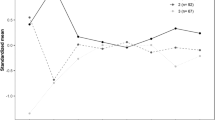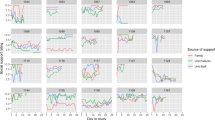Abstract
Research on the social influences associated with rates of non-suicidal self-injury (NSSI) is scarce and limited to studies of contagion within inpatient and residential treatment settings. Using an archival dataset that included 1,965 college students, the current study examined whether exposure to acts of NSSI and/or suicidal behavior in others was associated with increased rates of NSSI. Results supported hypotheses in that participants who knew someone who had engaged in NSSI only, or knew someone who engaged in both NSSI and suicidal behavior were more likely to have engaged in NSSI compared to those not exposed. The findings provide preliminary, albeit indirect, evidence of the potential for social modeling to influence rates of NSSI within college students. Directions for future studies are offered.
Similar content being viewed by others
References
Bandura, A. (1977). Social learning theory. Englewood Cliffs, NJ: Prentice-Hall.
Bandura, A. (2001). Social foundations of though and action: A social cognitive theory. Englewood Cliffs, NJ: Prentice-Hall.
Brent, D. A., Oquendo, M., Birmaher, B., Greenhill, L., Kolko, D., Stanley, B., et al. (2003). Peripubertal suicide attempts in offspring of suicide attempters with siblings concordant for suicidal behavior. American Journal of Psychiatry, 160, 1486–1493.
Gould, M., Jamieson, P., & Romer, D. (2003). Media contagion and suicide among the young. American Behavioral Scientist, 46, 1269–1284.
Gratz, K. L. (2001). Measurement of deliberate self-harm: preliminary data on the deliberate self-harm inventory. Journal of Psychopathology and Behavioral Assessment, 23, 253–263.
Hawton, K., Fagg, J., Simkin, S., Bale, E., & Bond, A. (2000). Deliberate self-harm in adolescents in Oxford, 1985–1995. Journal of Adolescence, 23, 47–55.
Joiner, T. E. (2003). Contagion of suicidal symptoms as a function of assortative relating and shared relationship stress in college roommates. Journal of Adolescence, 26, 495–504.
King, C. A., Franzese, R., Gargan, S., McGovern, L., Ghaziuddin, N., & Naylor, M. W. (1995). Suicide contagion among adolescents during acute psychiatric hospitalization. Psychiatric Services, 46, 915–918.
Laye-Gindhu, A., & Schonert-Reichl, (2005). Nonsuicidal self-harm among community adolescents: understanding the “whats” and “whys” of self-harm. Journal of Youth and Adolescence, 34(5), 447–457.
Leatherdale, S. T., Brown, K. S., Cameron, R., & McDonald, P. W. (2005). Social modeling in the school environment, student characteristics, and smoking susceptibility: a multi-level analysis. Journal of Adolescent Health, 37, 330–336.
Lieberman, M., Gauvin, L., Bukowski, W. M., & White, D. R. (2001). Interpersonal influence and disordered eating behaviors in adolescent girls: the role of peer modeling, social reinforcement, and body-related teasing. Eating Disorders, 2, 215–236.
Miller, A. L., Muehlenkamp, J. J., & Jacobson, C. M. (2009). Special issues in treating adolescent non-suicidal self-injury. In M. K. Nock (Ed.), Understanding non-suicidal self-injury: Current science and practice. Washington, D.C.: American Psychological Association Press (in press).
Muehlenkamp, J. J. (2007). Demographic questionnaire. Unpublished measure, University of North Dakota, Grand Forks, North Dakota.
O’Loughlin, S., & Sherwood, J. (2005). A 20-year review of trends in deliberate self-harm in a British town, 1981–2000. Social Psychiatry and Psychiatric Epidemiology, 40, 446–453.
Poijula, S., Wahlberg, K. E., & Dyregrov, A. (2001). Adolescent suicide and suicide contagion in three secondary schools. International Journal of Emergency Mental Health, 3, 163–168.
Rogers, J. L., & Rowe, D. C. (1993). Social contagion and adolescent sexual behavior: a development EMOSA model. Psychological Review, 100, 479–510.
Rosen, P. M., & Walsh, B. W. (1989). Patterns of contagion in self-mutilation epidemics. American Journal of Psychiatry, 146, 656–658.
Ross, R. R., & McKay, H. B. (1979). Self-mutilation. Toronto: Lexington Books, DC Heath.
Taiminen, T. J., Kallio-Soukainen, K., Nokso-Koivisto, H., Kaljonen, A., & Helenius, H. (1998). Contagion of deliberate self-harm among adolescent inpatients. Journal of the American Academy of Child and Adolescent Psychiatry, 37, 211–217.
Walsh, B. W. (2006). Treating self-injury: A practical guide. New York, NY: Guilford Press.
Walsh, B. W., & Rosen, P. (1985). Self-mutilation and contagion: an empirical test. American Journal of Psychiatry, 142, 119–120.
Whitlock, J., Eckenrode, J., & Silverman, D. (2006). Self-injurious behaviors in a college population. Pediatrics, 117, 1939–1948.
Whitlock, J., Eells, G., Cummings, N., Purington, A. (2007). Self-injurious behavior in college populations: Perceptions and experiences of college mental health providers. Manuscript submitted for publication.
Wood, M. D., Read, J. P., Pilfor, T. B., & Stevenon, J. F. (2001). Social influence processes and college student drinking: the mediational role of alcohol outcome expectancies. Journal of Studies on Alcohol, 62, 32.
Author information
Authors and Affiliations
Corresponding author
Rights and permissions
About this article
Cite this article
Muehlenkamp, J.J., Hoff, E.R., Licht, JG. et al. Rates of Non-Suicidal Self-Injury: A Cross-Sectional Analysis of Exposure. Curr Psychol 27, 234–241 (2008). https://doi.org/10.1007/s12144-008-9036-8
Published:
Issue Date:
DOI: https://doi.org/10.1007/s12144-008-9036-8




